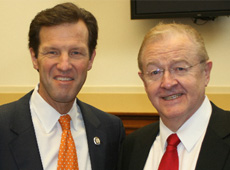Painting of Pope blessing King Billy shunned in shame but now SDLP man wants it to take pride of place up on Hill
Posted By: March 22, 2016
The painting by Dutch artist Pieter van der Meulen
A painting said to show the arrival of King William III in Ireland should be more prominently displayed at Stormont, a nationalist MLA has said.
The historic but deeply controversial work by Dutch artist Pieter van der Meulen was bought by the then unionist government in the 1930s.
But the canvas was rarely seen after unionists discovered it also shows the Pope – resting on a cloud – bestowing a blessing.
After being physically attacked for its “papist” inferences, the painting was stored out of sight for nearly half-a-century.
By the 1980s it was in the care of the Public Record Office in Belfast. More recently it has hung in the waiting area outside the Speaker’s office at Stormont.
But an SDLP Member now believes the canvas deserves a more public showing.
John Dallat said: “We are now at a point in time where we should be able to have a mature appreciation of paintings such as this.”
Entitled The Entry Of King William To Ireland – although some dispute the accuracy of this description – it was painted by van der Meulen, the Dutch monarch’s court artist.
After learning of the painting in the 1930s, the Stormont Government decided to buy it, and paid the princely sum of £209 and four shillings. But it did so without viewing the canvas.
On March 2, 1933, Prime Minister James Craig proudly announced that a new painting of King William would soon be displayed in Parliament Buildings.
Records from the time describe how his declaration drew cheers of joy from unionists.
Tommy Henderson, an independent unionist for Shankill, said it was “a delightful thing to have a portrait of King William hung in this illustrious house”.
He went on to suggest that the Prime Minister should use some of the Government’s hospitality fund to properly celebrate the occasion.
However, at the unveiling on March 7, the cheers soon turned to shock and anger.
The painting was not quite the triumphant crossing of the Boyne everyone had been led to believe.
Because in the top left-hand corner, above William’s head, was a purple-robed figure widely suspected to be Pope Innocent XI.
His right arm is extended, as if blessing the Prince of Orange.
Closer inspection showed what appeared to be a Franciscan friar in front of William’s horse holding rosary beads.
Newspaper reports recalled gasps of horror when MPs realised the Pope was in the painting. The next day unionist MP John Nixon asked Craig why a painting with the Pope was at Stormont.
“If he (Craig) wants a picture of that kind, I would suggest to him that he should hang it in his own house,” he told the chamber.
Nixon began plotting to get rid of the artwork.
Events took a dramatic twist when, in May 1933, he led a group of visitors from the Scottish Protestant League on a tour of Parliament Buildings.
When the group came face-to-face with King William and the Pope, they were outraged. Glasgow councillor Charles Forrester hurled red paint over Innocent XI.
His companion, Mary Ratcliffe, slashed at the friar’s rosary beads with a large kitchen knife. Both were arrested and fined £65 in Downpatrick court.
The painting was restored at a cost of £32 and 10 shillings. During restoration it was decided to remove the friar’s rosary beads.
The affair proved so embarrassing that the painting was hidden away in Parliament Buildings.
In 1975 it was moved to the Public Record Office, before being placed in the Speaker’s office at Stormont in 1983.
At one stage Ian Paisley took an interest in the painting.
Files released in 2012 under the 30-year rule said the former DUP leader was the “prime mover” in a request to have the painting returned to Stormont.
A letter to Northern Ireland Civil Service chief Sir Ewart Bell said: “The pressure for the return of the painting is being exerted by the Rev Ian Paisley, who desires it for his room at Stormont. Seemingly, he is very keen to have it.”
A separate letter warned that Mr Paisley was “unlikely to take no for an answer”.
According to the Assembly, the painting is now on display in the waiting area outside the Speaker’s office. But Mr Dallat, who is stepping down after 18 years as an MLA, feels a more public place would be fitting.
“There are a lot of paintings from bygone days that we are now sufficiently mature enough to display,” he added.
“In this particular case, our own history is so mixed up and intertwined that this painting captures it very well.”
Other paintings owned by the Assembly include portraits of former leaders, including Craig, Prime Minister from 1921 to 1940, and John Andrews, Prime Minister from 1940 to 1943.
More recent figures captured on canvas include Mr Paisley, Seamus Mallon, David Trimble and John Alderdice. One of the most recognisable works is ‘The House Will Divide’ by Noel Murphy, a 2003 painting showing a division as MLAs gather to vote. It hangs in the Senate chamber.










